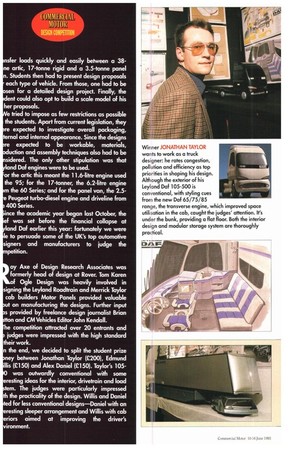First flight
Page 39

Page 40

If you've noticed an error in this article please click here to report it so we can fix it.
Under the skin, most modern tr much the same: ladder frame ch beam axle, engine, gearbox, and ancillaries. But drop a cab into there aren't many drivers who couldn' their Seddons from their Scanias or th from their Mocks.
None of this happens by accident, chassis and driveline design has con engineers work to the same goal, of productivity. At the same tim manufacturer wants to make sure its instantly recognisable.
The truck designer's job is a real ju Long-distance drivers want a large c cab, while the operator wants to minim and maximise payload. Then , despite European Market, there are national governing vehicle lengths, axle loa emissions limits. Usually, one basic des satisfy all these demands.
To find out what new ideas desig are bringing to trucks, we a Coventry University which runs undergraduate automotive design co UK. With sponsorship from Leyland Da a design competition for third-year s Coventry's four-year Transport Design degree course.
CM provided £1,000 in prize mone equipment on the course and £500 prizes. The University regularly see design projects for the professional pr of the course, so our competition was in the students' course work.
The brief included designing a nsfer loads quickly and easily between a 38ne artic, 17-tonne rigid and a 3.5-tonne panel n. Students then had to present design proposals each type of vehicle. From those, one had to be .sen for a detailed design project. Finally, the dent could also opt to build a scale model of his her proposals.
e tried to impose as few restrictions as possible the students. Apart from current legislation, they re expected to investigate overall packaging, ternal and internal appearance. Since the designs re expected to be workable, materials, • • uction and assembly techniques also had to be sidered. The only other stipulation was that land Daf engines were to be used.
or the artic this meant the 11.6-litre engine used the 95; for the 17-tonner, the 6.2-litre engine m the 60 Series; and for the panel van, the 2.5e Peugeot turbo-diesel engine and driveline from 400 Series.
.ince the academic year began last October, the ef was set before the financial collapse at land Daf earlier this year: fortunately we were le to persuade some of the UK's top automotive signers and manufacturers to judge the petition.
oy Axe of Design Research Associates was formerly head of design at Rover. Tom Karen of Ogle Design was heavily involved in signing the Leyland Roadtrain and Merrick Taylor cab builders Motor Panels provided valuable • ut on manufacturing the designs. Further input • s provided by freelance design journalist Brian ion and CM Vehicles Editor John Kendall. e competition attracted over 20 entrants and • judges were impressed with the high standard their work.
n the end, we decided to split the student prize • ney between Jonathan Taylor (£200), Edmund His (£150) and Alex Daniel (£150). Taylor's 105 • was outwardly conventional with some eresting ideas for the interior, drivetrain and load .tem. The judges were particularly impressed th the practicality of the design. Willis and Daniel ted for less conventional designs—Daniel with an -resting sleeper arrangement and Willis with cab -riors aimed at improving the driver's vironment.












































































































